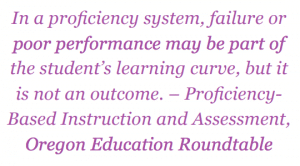How Competency-Based Education Differs from the Traditional System of Education
CompetencyWorks Blog
This is the fourth post in the blog series on the report, Quality and Equity by Design: Charting the Course for the Next Phase of Competency-Based Education.
 Across the country, schools, districts and states are replacing the traditional, time-based structure with one that is designed to help each student reach proficiency. Educators organize learning in a variety of ways that respond to students and are designed to motivate and engage students in mastery of their own learning. Competency-based structures are also designed to ensure students reach proficiency so that students and parents are confident that their students are learning what they need to as they advance towards graduation.
Across the country, schools, districts and states are replacing the traditional, time-based structure with one that is designed to help each student reach proficiency. Educators organize learning in a variety of ways that respond to students and are designed to motivate and engage students in mastery of their own learning. Competency-based structures are also designed to ensure students reach proficiency so that students and parents are confident that their students are learning what they need to as they advance towards graduation.
Below is the working definition of competency-based education. (Please note: the working definition is being updated and a logic model being developed to be released in second quarter of 2018).
 Students advance upon demonstrated mastery — By advancing upon demonstrated mastery rather than on seat time, students are more engaged and motivated, and educators can direct their efforts to where students need the most help.
Students advance upon demonstrated mastery — By advancing upon demonstrated mastery rather than on seat time, students are more engaged and motivated, and educators can direct their efforts to where students need the most help.
 Competencies include explicit, measurable, transferable learning objectives that empower students — With clear, transparent learning objectives, students have greater ownership over their education.
Competencies include explicit, measurable, transferable learning objectives that empower students — With clear, transparent learning objectives, students have greater ownership over their education.
 Students receive timely, differentiated support based on their individual learning needs — Students receive the supports and flexibility they need, when they need them, to learn, thrive and master the competencies they will need to succeed.
Students receive timely, differentiated support based on their individual learning needs — Students receive the supports and flexibility they need, when they need them, to learn, thrive and master the competencies they will need to succeed.
 Assessment is meaningful and a positive learning experience for students — New systems of assessments give students real-time information on their progress and provide the opportunity to show evidence of higher order skills, whenever they are ready, rather than at set points in time during the school year.
Assessment is meaningful and a positive learning experience for students — New systems of assessments give students real-time information on their progress and provide the opportunity to show evidence of higher order skills, whenever they are ready, rather than at set points in time during the school year.
 Learning outcomes emphasize competencies that include application and creation of knowledge, along with the development of important skills and dispositions — Personalized, competency-based learning models meet each student where they are to build the knowledge, skills and abilities they will need to succeed in postsecondary education, in an ever-changing workplace and in civic life.
Learning outcomes emphasize competencies that include application and creation of knowledge, along with the development of important skills and dispositions — Personalized, competency-based learning models meet each student where they are to build the knowledge, skills and abilities they will need to succeed in postsecondary education, in an ever-changing workplace and in civic life.
The section below illustrates key differences between competency-based education as compared to traditional education systems, and offers examples of how competency-based systems can embed an intentional focus upon equity.

To learn more about how competency-based education differs from the traditional K-12 education system, follow this blog series or download the full report: